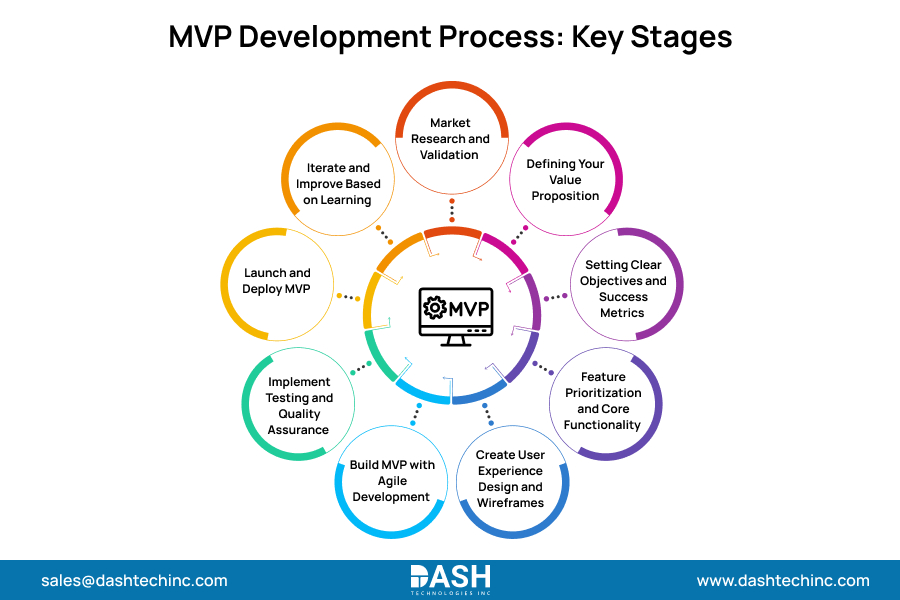Startup MVP Development Guide 2025: From Concept to Market
Creating a Minimum Viable Product (MVP) is a key step for any startup. MVP development represents an initial product version creation that includes just enough essential features that enable early adopters to use it while providing feedback for future development. Startups can test business assumptions and confirm market demand while reducing risks prior to investing major resources through this strategic approach.
MVP development plays a crucial role in startup success because 90% of startups fail, and 34% of those failures result from poor product-market fit. The systematic development of MVPs enables startups to enhance success rates through better resource management and faster market entry.
What is MVP Development?
The development of MVP is a product development approach that aims to produce a leaner variant of your product with only a few necessary features required to address the core issue for your target market. An MVP is not a fully developed product with all its features, but rather a learning tool used to prove business hypotheses through actual user input and market testing.
The main reason MVP creation is important to startups goes beyond simple cost reductions. It facilitates quick market verification, minimizes development risk, and delivers vital understanding of user behavior and patterns prior to scaling. This strategy aligns with lean startup practice, which focuses on validated learning through iterative product releases and feedback.
MVP vs. Prototype vs. Full Product

It is important to know the difference between MVP, prototype, and final product to succeed as a startup. Prototypes serve for internal evaluation of functionality and design concepts. At the same time, an MVP represents a functional product released to real users for market validation. Full products encompass the entire vision with every intended feature and capability.
The distinguishing factor is purpose and audience. Prototypes are for development teams, MVPs are for early adopters, and full products are for the mass market. This progression enables startups to mature their knowledge of user needs in an orderly fashion while maintaining resource allocation effectively.
Essential Steps in the MVP Development Process

Market Research and Validation
Market research provides essential insights into target demographics and existing solutions when developing an effective Minimum Viable Product (MVP). The research stage requires the examination of market dimensions alongside competitive product analysis and customer payment readiness for your solution. Startups need to confirm the existence of real market demand prior to investing resources into development.
Market validation involves conducting customer interviews in conjunction with surveys and performing competitor analysis to identify market gaps and opportunities. Analyzing the behaviors and needs of your target audience, along with their current solution options, helps you determine important features and how to effectively position your product.
Defining Your Value Proposition
A strong value proposition is at the heart of effective MVP app development. This statement should articulate the specific problem your product solves, the target audience it serves, & the unique benefits it provides. Effective value propositions focus on outcomes rather than features, emphasizing the transformation of users’ experience.
Feature prioritization decisions and sustained development focus depend on the value proposition. MVP development for startups needs to convey their value proposition that resonates with their intended audience.
Setting Clear Objectives and Success Metrics
Having measurable goals and key performance indicators (KPIs) is the secret to the success of an MVP. The metrics should be aligned with your business objectives and be actionable in making decisions while creating further development. The standard metrics for evaluating MVPs encompass user acquisition rates, engagement levels, retention rates, and conversion metrics.
Success indicators must be SMART, i.e., specific, measurable, achievable, relevant, and time-bound. This approach allows objective progress to be quantified and fact-based decisions rather than educated estimates.
Feature Prioritization and Core Functionality
The concept of “minimum” defines the essence of MVP software development. This phase requires brutal feature prioritization to pinpoint the fundamental elements that represent your primary value proposition. The addition of each new feature drives up your MVP development costs while prolonging your time to market.
Popular prioritization frameworks include the MoSCoW method (Must have, Should have, Could have, Won’t have), the Kano model for customer satisfaction analysis, and RICE: Utilize the RICE framework to evaluate features through Reach, Impact, Confidence, and Effort metrics. The orderly process ensures that resources are only allocated to features that generate the highest value for users and business objectives.
Create User Experience Design and Wireframes
Develop wireframes alongside user flows and prototypes to show the interaction dynamics between users and your MVP throughout the design process. Prioritize simple design elements and user-friendly features, ensuring your design effectively reflects your fundamental value proposition.
Start with low-fidelity wireframes to determine the information architecture and user flows for your MVP app development. Advance to high-quality mockups that establish both visual design components and behavioral interaction patterns. Validate usability assumptions by testing design concepts with potential users.
Build MVP with Agile Development
Release your MVP on agile development principles that allow you to iterate quickly and continue to incorporate feedback. Break MVP development for startups into short sprints with well-defined outputs and repeated review cycles for incorporating regular feedback and course correction.
Agile teams use ongoing requirement and result evaluations to apply user feedback and market insights in their change implementation process effectively. The methodology enables rapid experimental development of MVPs while maintaining required quality standards.
Build Your MVP with Dash
We work with ambitious founders to design, build, and launch MVPs that are scalable, efficient, and market-ready — without any guesswork.
Let’s Connect!Implement Testing and Quality Assurance
Develop testing procedures that balance quality with efficiency to deliver seamless user experiences. Utilize automated testing to facilitate rapid iteration cycles without compromising product reliability.
Verify feature performance through functional testing while validating user experience design using usability testing and confirm system response times by performing performance testing. Address critical issues before launching while documenting minor improvements for future iterations.
Launch and Deploy MVP
Move your MVP to the production environment and provide access to both early adopters and your target user base. Develop a soft launch framework that ensures controlled user integration and technical issue management before the product reaches the wider market.
Establish systems that monitor both performance and user activity and detect potential problems. Develop customer support processes to efficiently address user inquiries and feedback throughout the initial launch phase.
Iterate and Improve Based on Learning
Use collected feedback and performance data to plan and implement improvements through structured iteration cycles. Prioritize updates that address the most critical user problems and advance business objectives.
Keep iteration cycles fast while ensuring the process is secure by thoroughly testing changes to prevent new issues from arising. Share updates about implemented improvements to show users that their feedback matters, which will help build their loyalty.
Conclusion
Creating an effective MVP development for startups requires more than just product deployment, as it involves validating your business concept through user feedback and establishing foundations for future growth. Your MVP functions both as a product and a learning mechanism that supports the validation of your business theory while providing market insights to develop a full-functioning product. Your MVP findings will guide all later decisions, including feature development and market expansion planning.
Want to transform your startup idea into a market-ready MVP? Innovators trust Dash as their MVP development agency partner. Let’s build your product’s future, faster. The MVP development agency for startups is ready to guide you through your MVP journey beginning today.
About Dash

Dash Technologies Inc.
We’re technology experts with a passion for bringing concepts to life. By leveraging a unique, consultative process and an agile development approach, we translate business challenges into technology solutions Get in touch.







